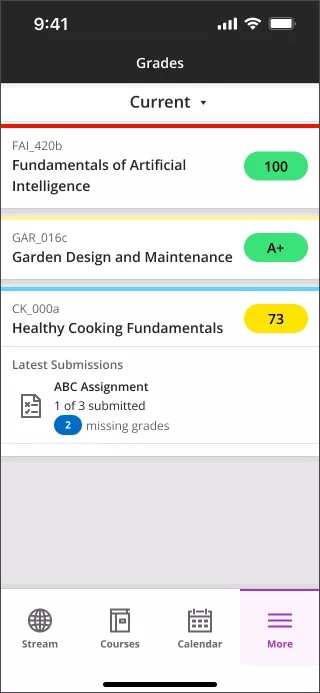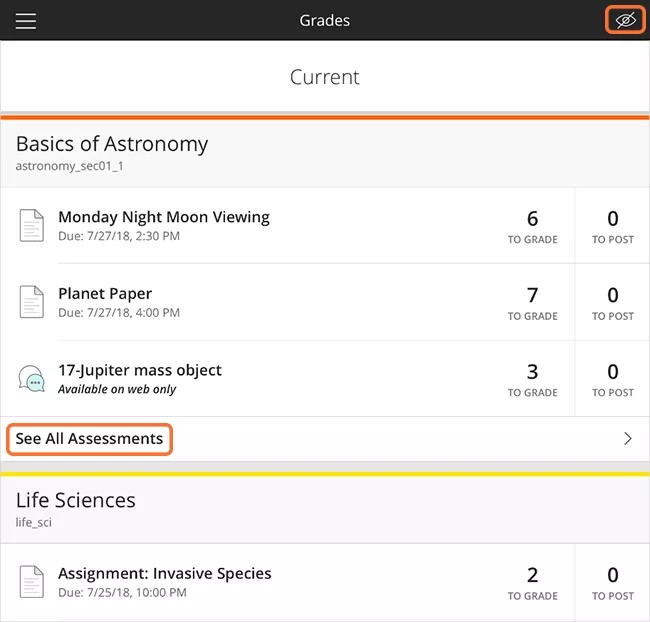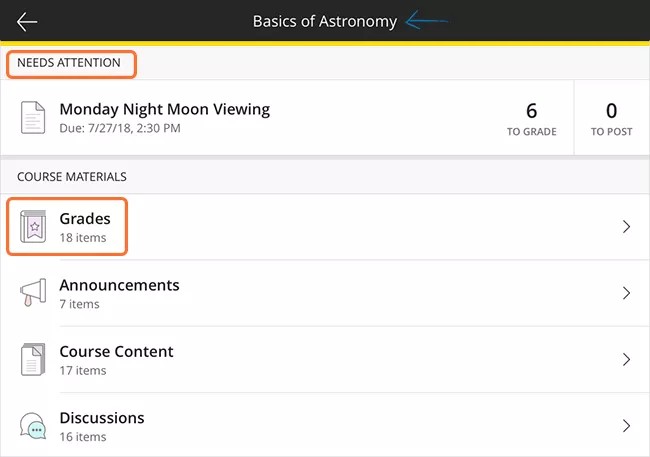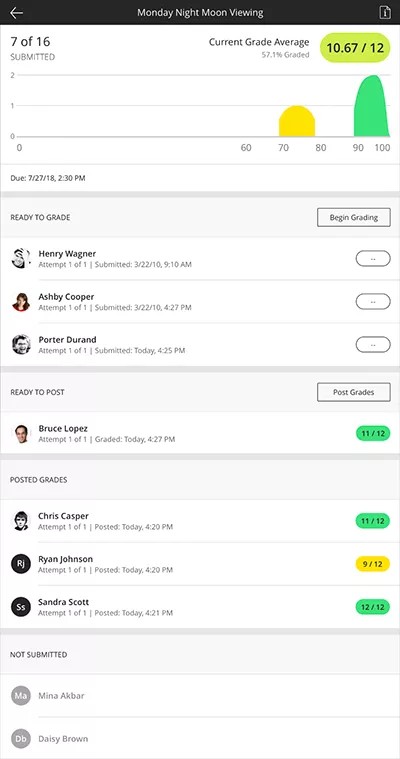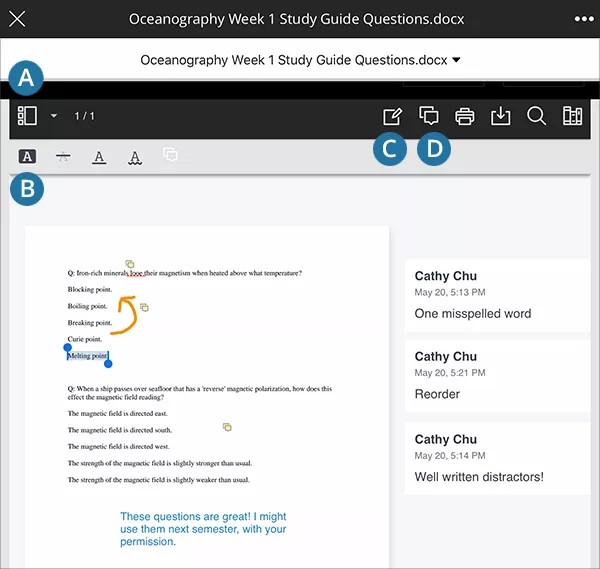On this page, learn about:
Grades for students
You can access your grades in two ways.
- Select More on the main menu, then select Grades.
- From an individual course:
- Select Gradebook for an Ultra course
- View Course Overview in an Original course
Grades for all courses
Select Grades on the main menu to see a quick view of your overall grades for all courses. Your instructor's settings determine whether your grade is displayed as a letter, percentage, or points. The Grades page displays three items at a time, and each grade pill displays corresponding grade colors.
Grades for individual courses
Original Course View
In a course, your current grade is displayed at the top of the Course Overview. Select the course grade to view your graded work.
Ultra Course View
Select a course to view items that your recently graded work and activities due within seven days. Select View More to access the gradebook for all graded work in your course. Select an item to navigate to that specific assessment or activity.
View your graded work
Original Course View
After you access grades from the main menu or an individual course, select a course grade to see your submitted assignments, tests, quizzes, and graded discussions.
To return to grades for all courses, select the back arrow until the Menu button appears. Next, select Grades.
- When you select a graded discussion, you see the entire discussion. To see a collection of your own posts, access your course on a web browser.
- Grading rubrics are listed under Details if your instructor associated a rubric with the item. In the app, you can view the rubric to see descriptions and point values for each criterion. Access your course on a desktop web browser to see the points earned and written feedback for each criterion as well as overall rubric feedback from your instructor.
- You may see calculated grades, such as running totals, if your instructor uses them. Select a graded item to view its details, a list of your attempts, and the dates and times you submitted.
View attempts
In addition to your grades, you can view your test and assignment attempts in the app.
Ultra course attempts:
- Assignment attempts are visible.
- Test attempts are visible. Your instructor chooses whether you can view the correct answers or just the questions.
Original course attempts:
- Assignment attempts are visible.
- Test attempt visibility depends on test settings your instructor chose. If you can't view your attempt in the app, access it in a web browser instead.
View feedback
For tests and assignments, your instructor may provide feedback on your attempt with your grade. The feedback you see in the app differs for Ultra and Original Courses.
Ultra course test and assignment feedback can contain:
- Rich text
- File attachments*
- Multimedia
- Inline grading notes on submitted files
There is a maximum file size limit of 300MB in order to ensure performance.
Original course test and assignment feedback can contain:
- Plain text only. Access your course on a desktop browser to see rich text feedback.
- Response feedback for individual answers is not visible in the app. To review this type of feedback, access your course on a desktop browser to view it.
Grade rounding in the app
The Blackboard app enforces these rounding rules that may cause grades to display differently than from the Blackboard Learn desktop browser experience. Check your grade on a web browser to view all available decimals.
- If the score or percentage is greater than 100, it is rounded to the nearest whole number.
- If the score or percentage is less than 100, it is rounded to 2 decimal places.
- Insignificant figures are not displayed.
Grades for instructors
On the Blackboard app, you can review, annotate, grade, and publish the grades to students.
Grading is supported on the Blackboard app on phones and tablets. The interface is slightly different between phones and tablets.
Access grading
You can access grading in two ways:
- Select More on the main menu, then select Grades.
- From an individual course:
- Select Gradebook for an Ultra course.
- View Course Overview in an Original course.
Grades for all courses
Select Grades on the main menu to see which courses have assignments that need grading. On the Grades landing page, you can see the overall course grade for your courses. The page displays three items at a time, and each grade pill displays corresponding grade colors.
Select a course to see items that need grading. You can access grading tasks by selecting that item. The View More link on the grades page navigates you to the gradebook for that course.
Select an individual assignment to see its submissions and grades. Select See All Assessments to view all graded items for that course.
The Grades page displays up to three assessments with due dates that need your attention for each course. Select See All Assessments to check if more assessments are ready to grade or post.
On the Grades page, you can hide courses you don't need to focus on. Select the Show or Hide Courses icon, select the courses to hide, and select Save. Select the icon again to show a hidden course. Or select the card at the end of the list that states the number of hidden courses.
Grades for individual courses
When you're in an Original course, you can see assessments that need your attention immediately on the course overview. You can also select Grades to view all assessments.
View submissions
After you access Grades from the main menu or an individual course's overview, select an assignment to see its submissions.
The submission list is divided into sections to help you focus your efforts.
- Summary. Shows how many of your students submitted this assignment and the overall class average for posted grades. On tablets, you also see a grade distribution graph.
- Assessment Detail. Provides information such as due date and number of attempts. You can also view file attachments or the rubric used for grading. On tablets, select the information icon to access the details.
- Ready to Grade. Students submitted this work and you can start grading.
- Ready to Post. Submissions are graded and ready to publish to students.
- Posted Grades. These grades are published to students.
- Not Submitted. These students haven't submitted the assignment.
Just select a submission in the Ready to Grade section to start grading.
Administrators can turn off grade pill color display. When turned off, the grade pills appear with dark backgrounds and white grades.
Grade assignments
In the app, grading is a two-step process. First grade the item and then post the grade for students to see. Students don't see their grades until you post them. You can post grades as you go or all at once when you've finished grading.
Each time you add a grade, feedback, or inline annotation, your changes are securely synced to Blackboard Learn and all your devices.
- Access an assignment from the main menu or within an individual course.
- On the submission list, select Ready to Grade.
- Select a student submission. Or, you can select Begin Grading to start grading the submissions in succession.
- Review the student's submitted content and files. More on inline annotations for assignment files.
- Select the information icon if you want to refer to the assignment instructions, rubric, and other details.
- Select the feedback icon to add overall feedback on the student's work.
- Select the grade pill and type a grade. Remember, the grade isn't visible to the student until you post the grade. More on posting grades in the app.
Inline annotations for assignment files with Bb Annotate
Students can submit assignment work as attached files, and you can provide notes directly in the file. Your annotations are saved in the system and students can see them in a web browser view of their course.
If the submitted file (not converted) is greater than 300MB, processing will stop, in order guarantee no data loss and good performance.
For Ultra courses, students can also view annotations in the Blackboard app. For Original courses, students aren't able to view file annotations in the Blackboard app.
Access a student's assignment attempt and open an attachment. If there's more than one attachment, select the arrow next to the file name to select a different file. You can annotate one file at a time.
This image shows the app on a tablet. Some functions, such as the Content Library and display of comments next to a file, are not available on smaller devices due to limited screen size.
- Change your view. Select the arrow next to the page view icon to select an alternate view such as page thumbnails or a list of all annotations. Select the page view icon to switch between the full page view and your selected alternate view. Select the file name to view another attachment.
- Select text in the file to open an additional menu. You can highlight, strikethrough, underline, squiggle, or comment on the selected section.
- Draw, insert images, insert stamps, or add text to the file.
- Place a comment. Select the comment icon and then select anywhere in the file to place a comment. In the text box, type or use your device's dictation capability to create text. All comments show next to the document.
Additional functions in the menu bar enable you to search the text. You can also use the Content Library to create a bank of reusable comments, if available on your system. You can add, edit, delete, and search comments in the library. You can insert one of your stored comments directly to the assignment file.
The app doesn't support download or print functions for assignment files or annotations.
Select any annotation in the file and select one of the edit functions in the menu bar to make changes. You can also delete the annotation permanently.
When you close the annotation screen, your changes save and securely sync to Blackboard Learn and all your devices.
Bb Annotate sessions expire after one hour. A message lets you know you can refresh the page to continue. Your annotations, feedback, and files are saved so that you can resume your work.
More on Bb Annotate in the web browser view of your course
Rubrics
If a rubric is associated with the assessment, it displays after you select the grade pill. Select the appropriate achievement levels and the grade is calculated automatically. To override the overall rubric grade, select the grade pill or Manual Override. You can't override grades for individual rubric criteria or achievement levels.
For Original courses, if more than one rubric is associated with an assessment, the rubric designated as Used for grading is used in the app. Ultra courses allow only one associated rubric per assessment.
Post grades
After you grade one or more submissions, return to the submission list to post the grades so they're visible to students.
- If needed, close a grading window. Select the back arrow to navigate to the submissions list.
- Select Ready to Post to view the list.
- Select Post Grades.
- Clear the check box for items you don't want to post.
- Select Post Selected to publish those grades to students.
The grades you posted now appear under Posted Grades on the submission list.
After you post grades in the app, you need to access the course in a web browser to edit grades and feedback.
For Original course tests that are autograded, submissions are posted automatically. In the app, these submissions show in a course's grading overview in the Posted section.
For Original courses, students need to access their courses in a web browser to view your New Box View annotations on submitted documents. The Blackboard app supports New Box View annotations only for an Ultra course. Learn more
What can I grade?
You can use these grading features in the app:
- Grading for assignments
- Points, text, percentage, and letter grades
- Grading with associated rubrics
These grading features are not available in the app at this time:
- Grading tests**
- Grading group submissions**
- Grading discussions, blogs, wikis, and journals**
- Anonymous and delegated grading**
- Audio and video feedback
- Offline grading
**Designated as Available on web only in the app. Access your course in a web browser to grade these assessments.
These enhancements are planned for future releases:
- Grading assignments for Ultra courses*
- Grading tests*
Is grading available to me in the app?
Grading capabilities are available in Blackboard Instructor version 2.0+ for these conditions:
- Blackboard Learn SaaS or Blackboard Learn 9.1 Q2 2018 CU4 +
- Devices running Android 4.2+ or iOS 9+
Clients on Blackboard Learn versions prior to Q2 2018 need to upgrade to Q2 2018 in order install the necessary CU for grading capabilities.
More information on system requirements for grading in the app
Preview assessments
In Blackboard Instructor, navigate to Course Content and access tests and assignments. This preview shows course assessments as students see them in the Blackboard app.
What do students see?
Instructors can grade assignments in the Blackboard Instructor app and can grade all other items in a web browser view of a course.
Students can view scores in these ways:
- Blackboard app for students on the Grades page: Students select a graded item to see their attempts, scores, and feedback depending on the item type.
- Blackboard app for students in Course Content: Students select a graded item to see their attempts, scores, and feedback depending on the item type.
- In a web browser view of a course, students can view attempts, scores, and all feedback you provided, including inline annotations.
Show Original course test attempts to students
For Original courses, students see their scores after a test is graded. If you want to also show students their full attempt, including Feedback to the learner, you need to select specific test options.



